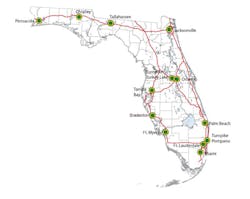Truck parking is a capacity, geographic, and even political problem in Florida, according to Tisha Keller, vice president of Florida’s Trucking Association. And as a result, truck drivers are having a tough time finding a safe, legal place to park.
Keller cited one particular problem spot along the I-4 corridor, where many abutting neighborhoods oppose truck parking. “Because the rest area on I-4 is the only rest stop in that area, all trucks park there,” she explained, adding that as the area begins to overflow, highway patrolmen push truckers out.
“The driver says: ‘Where am I supposed to go? I’m out of hours; I’m supposed to stop,’” Keller continued.
Because of these types of circumstances, several truck drivers resort to the unsafe and illegal methods of parking on the interstate mainline, ramp shoulders, or in vacant lots. Keller added that security has always been a problem in Florida as the state consistently ranks high for cargo theft.
After conducting a study with Florida International University to assess parking lot utilization and technology use, Florida Dept. of Transportation (FDOT) found the biggest problem statewide is an imbalance of truck parking capacity due to a lack of parking information management. FDOT found an overflow of parking at some locations while others remain underutilized.
To help solve that problem, FDOT is in the process of installing a Truck Parking Availability System (TPAS) along I-4, I-10, I-75 and I-95, including at welcome centers, weigh stations, and rest areas.
Jeff Frost of FDOT’s Commercial Vehicle Operations/Traffic Incident Management, Office of Traffic Engineering & Operations, told Fleet Owner that the study involved collecting parking data at all of the public rest areas along I-10, I-75 and I-95. Based on the results of the study, FDOT submitted and was awarded an Accelerated Innovation Deployment grant to deploy a real-time information system about commercial vehicle parking availability.
“TPAS will help truck drivers maximize their HOS requirements by reducing the amount of time spent to find parking spaces, allowing them to focus on the movement of goods,” Frost said. “Initially TPAS will allow drivers to see how many spaces are currently available at a typical location. After we have collected enough historical data, we hope to develop prediction models to project future availability estimates.”
TPAS will use in-ground sensors in the truck spaces at interstate rest areas/welcome centers, and entrance and exit counts at weigh stations to monitor the number of available truck parking spaces. Project consultant Craig Toth, West Florida’s operations manager for HNTB Corp., said the information will then be displayed on the state’s FL511 website and app for drivers to access. FDOT said it will also make the information available for third-party apps.
“It’s in real time, so it won’t do predictive analysis yet,” Toth explained. “But over time, as the system stabilizes, we’ll be able to do predictive-type analyses.”
“Overall, it should really help from a safety and operational standpoint,” Toth added. “It’s a national issue, and we’re looking to get in front of it. It would be nice to expand along the entire I-75 and I-95 corridor systems.”
Keller said the system is the first step toward connecting trucks with open and available spaces, but more needs to be done to address the bigger problem.
“We are thrilled by it, but in the end, we need the state to invest in real estate for truck parking,” she said. “From our perspective, DOT needs to really prioritize the needs of the industry as much as they do other industries. We move 75-80% of the freight in Florida, and I sometimes think that truck parking and our needs aren’t prioritized.”
“We have a great partnership with DOT,” Keller added. “This is just one of those issues that’s really politically sensitive, and it’s getting worse.”
The TPAS is in preliminary design and will be deployed as a series of design-build projects led by each FDOT district. FDOT anticipates the project will be done in phases through 2017.
Inadequate truck parking continuously pops up as a top concern among truck drivers and carriers nationwide. In fact, it just ranked number four on the annual top 10 list of trucking industry issues compiled by the American Transportation Research Institute (ATRI) – that’s up a spot from 2015, according to ATRI president and COO Rebecca Brewster.
“As the lack of available safe parking continues to challenge the industry as a top concern, it’s clear that multiple solutions will be needed,” Brewster said. “Providing real-time information to drivers about truck parking availability is a great start so that valuable drive time isn’t wasted as drivers look for a safe place to stop.”





